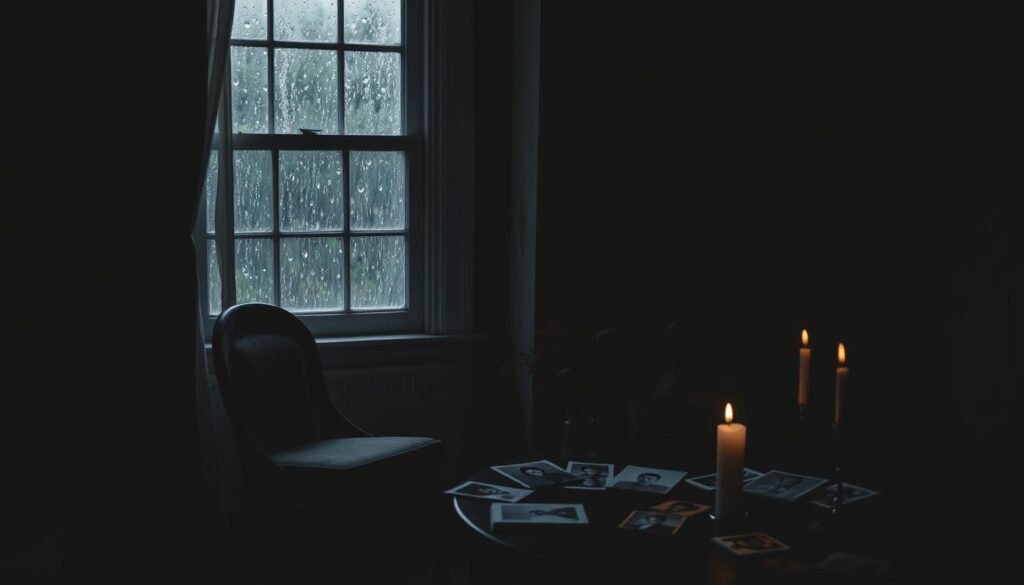Have you ever felt sad and wondered if it’s more than just a bad day? Finding out if these feelings mean you have reactive depression can be hard. This mood disorder usually comes after big life stressors. It changes how you feel and act every day.
About one in six people will face a major depressive episode during their life. Knowing the early signs is key. Symptoms can last for weeks or months. They can affect your work, your relationships, and how you enjoy life. This article will help you recognize signs of reactive depression. Recognizing these signs early can help you get help sooner. This can improve your mental health in the long run.
Key Takeaways
- Reactive depression can arise after significant life changes or stressors.
- Identifying early warning signs helps in seeking timely support.
- Symptoms can last for extended periods, affecting daily activities.
- Approximately 16 million adults in the U.S. experience clinical depression annually.
- Professional help can include therapy and lifestyle changes.
- Recognizing the difference between grief and depression is vital for appropriate treatment.
Understanding Reactive Depression
Reactive depression, or situational depression, happens due to big life changes or stress. People with this issue may feel mood changes caused by things like divorce, losing a job, or getting very sick. Unlike major depressive disorder, reactive depression is linked to specific events. It turns into adjustment disorder with depressed mood within three months of the stress.
People with reactive depression may feel sad, easily upset, or lose interest in things. They might also eat or sleep too much or too little. This condition can make people very tired and even think about suicide. It’s important to notice these symptoms early to get help and support.
Doctors look for clear external triggers to diagnose reactive depression. If the symptoms last more than six months, it might be major depressive disorder (MDD). Usually, if the cause of the stress goes away, the person starts to feel better within six months.
Making changes in how you live can help a lot with reactive depression. Doing things like exercising, trying meditation or yoga, eating healthy, and having good friends can reduce symptoms. Knowing how to manage life’s ups and downs is key to feeling better when facing reactive depression.
Symptoms of Reactive Depression
It’s important to understand the symptoms of reactive depression. These symptoms fall into three categories: psychological, physical, and social. Knowing them helps provide the right support.
Psychological Symptoms
Those with reactive depression face many psychological symptoms. These include:
- Persistent sadness or low mood
- Feelings of hopelessness and helplessness
- Heightened anxiety and irritability
- Low self-esteem and self-worth
- Tearfulness or emotional outbursts
Physical Symptoms
Physical symptoms can greatly affect daily life. They cover:
- Fatigue or loss of energy
- Changes in appetite, with weight gain or loss
- Sleep issues, like insomnia or sleeping too much
- Unexplained body pains, like headaches or stomach problems
Social Symptoms
Social symptoms show the struggle in keeping up with relationships and interests. These symptoms are:
- Withdrawing from friends and family
- Ignores hobbies and social events
- Problems at work or school
Knowing these psychological, physical, and social symptoms is key. Early spotting and help can lead to effective treatment for situational depression.
Signs of Reactive Depression
It’s important to spot the signs of reactive depression early. These signs show up as emotional changes and actions that stand out. Knowing these can help us and those we care about find help when it’s needed.
Emotional Changes
People with reactive depression see big changes in their feelings. They may feel:
- Heightened irritability
- Intense sadness
- Apathy towards activities
These emotional ups and downs can be a clue that someone is struggling with life’s challenges. Spotting these changes helps us talk better and support each other.
Behavioral Indicators
Behavioral signs also show up along with emotional ones. These behaviors might be:
- Social withdrawal
- Decreased motivation in daily tasks
- Neglect of personal responsibilities
These actions often signal a deep fight with stress’s mental toll. Recognizing and addressing these signs early can help in finding ways to manage stress better. This prevents the situation from getting worse.
Distinguishing Grief Reaction from Depression
It’s very important to know the difference between grief reaction and depression. Grief comes naturally after a loss. It brings sadness and a feeling of missing someone. But, usually, it gets better with time. Depression, however, has lasting symptoms that can interrupt everyday life. Knowing these differences helps people find the right help when they need it.
Before, experts said not to diagnose someone with depression right after a big loss. This was to avoid mistakes. It was called the “bereavement exclusion.” Studies show that about 42% of those grieving might feel deep sadness early on. And, 16% could still feel down after one year. This shows why it’s critical to tell the difference between grief and. Sometimes, grief can even trigger depression.
Depression is known by deep sadness, losing interest in what we enjoy, and struggles in daily life. While grief has some of these, it doesn’t last as long or feel as intense. If grief continues for over a year, it might turn into prolonged grief disorder (PGD). PGD causes deep emotional pain. Recognizing these signs early can lead to the right help and support.

| Aspect | Grief Reaction | Reactive Depression |
|---|---|---|
| Duration | Typically improves over time | Persists beyond expected time frame |
| Emotional Response | Sadness and longing | Hopelessness, worthlessness |
| Functional Impact | Temporary disruption | Significant impairment in daily life |
| Common Symptoms | Yearning for lost loved one | Pervasive sadness, loss of interest |
When we lose someone, understanding these differences is key to healing. Getting help from experts, like those at Aurora Behavioral Health System, is very important. They can guide us through grief and depression in the best way.
What is Situational Depression?
Situational depression happens when big life stressors occur. It usually shows up within three months after the stressful event. People may feel sad, lose interest in everyday things, have changes in sleep and appetite, and experience emotional outbursts.
The severity of situational depression varies. It usually goes away within six months if the cause is taken care of. It’s triggered by specific events like a breakup, money problems, or losing a job. This is different from major depressive disorder, which doesn’t need a specific cause and lasts longer.
A diagnosis requires the symptoms to greatly upset someone and upset their daily life. Things like past mental health issues, previous trauma, and family history of depression can increase the risk. It’s important to spot these symptoms early for quick treatment. Treatment might include therapy and lifestyle changes.
For mild situational depression, taking care of oneself might be enough. But severe cases might need professional help. This could be one-on-one counseling, group support, or medicine like antidepressants. Tackling the symptoms and their cause is key to getting better.
| Symptoms of Situational Depression | Potential Treatment Options |
|---|---|
| Sadness | Individual counseling |
| Difficulty enjoying activities | Group support |
| Changes in sleep or appetite | Medications (antidepressants) |
| Emotional outbursts | Lifestyle modifications (e.g., exercise, healthy diet) |
Knowing about situational depression helps in taking care of our mental health. Getting help when mood swings happen can really help in recovery. You can learn more about its signs, symptoms, and treatments here.
Common Triggers of Reactive Depression
Reactive depression is a type of depression. It comes from tough life events and personal challenges. These can greatly influence someone’s mental well-being. It’s important to know the common triggers. This knowledge helps in spotting signs of reactive depression early on.
Life Stressors
Life stressors are big reasons for reactive depression. Examples include:
- Job loss or unemployment
- Relationship problems, such as divorce or separation
- Financial issues that make daily life hard
- Loss of a loved one, leading to deep sadness
These stressors can bring on strong feelings and thoughts. This makes daily tasks hard to do. Knowing these stressors can help stop reactive depression from getting worse. It also encourages people to get help when needed.
Personal Challenges
Personal problems often lead to reactive depression. These problems can be:
- Long-term sickness that changes how you live
- Big life changes, like retiring or moving
- School or work pressure
- Feeling alone or cut off from friends and family
When these problems get too big, they can make you feel very sad and anxious. Recognizing these issues as triggers can motivate someone to get help. It also helps with finding ways to deal with emotions better. For more on different types of depression, check out this useful link.

Differences Between Situational and Clinical Depression
It’s crucial to know the differences between situational and clinical depression. This knowledge helps with getting the right help. Situational and clinical depression are not the same. They vary by how long they last, how severe they are, and their causes.
Duration and Severity
Situational depression usually comes quickly after a stressful event. It often gets better in less than six months, even without treatment. Clinical depression is different because it lasts a lot longer. It comes with symptoms that make everyday tasks hard. People with clinical depression have a tougher time for longer periods, sometimes years.
Identification of Stressors
Knowing the cause is key to understanding situational depression. It happens after specific stressful events. When the cause is dealt with, the depression often goes away. But clinical depression doesn’t need a clear cause to appear. This fact shows why treatments need to be different for each depression type.
| Aspect | Situational Depression | Clinical Depression |
|---|---|---|
| Duration | Short-term, usually resolves within 6 months | Chronic, can last for years |
| Severity | Mild to moderate; often does not require treatment | Severe; may require psychotherapy and medication |
| Stressor Identification | Identifiable stressors likely lead to symptoms | May occur without any identifiable stressor |
Treatment Options for Reactive Depression
Dealing with reactive depression means looking at many treatment options. It’s about combining therapy and making changes in daily life. Together, these steps help improve someone’s life quality.
Therapeutic Interventions
Cognitive-behavioral therapy (CBT) is a key tool against reactive depression. It teaches people how to handle tough times and change negative thoughts. Usually, CBT takes about 8 to 16 sessions, depending on how severe the depression is.
Other therapies that help include:
- Interpersonal Therapy (IPT): Focuses on improving relationships in 8 to 16 sessions.
- Behavioral Activation Therapy: Aims to lift mood by boosting activity over 12 to 16 sessions.
- Individual Problem-Solving Therapy: Offers help for specific issues in 6 to 12 sessions.
- Psychodynamic Psychotherapy: Delves into deep-seated reasons for depression in 8 to 16 sessions.
Doctors often suggest antidepressants for the tougher cases of depression. Combining medication with therapies like CBT works better. Regular check-ins with a doctor help adjust the treatment plan.
Lifestyle Modifications
Changing your lifestyle can also battle reactive depression. Things like exercising, sleeping well, and eating right are crucial. These habits boost your mood and help you fight off depression in the future.
- Engaging in Regular Physical Activity: Working out makes you feel good by releasing endorphins.
- Prioritizing Sleep: Good sleep is key for feeling emotionally and physically strong.
- Eating a Balanced Diet: What you eat affects your mood and energy.

By mixing therapy with lifestyle changes, dealing with reactive depression gets easier. Everyone’s experience is different, so it’s important to find what works for you.
Seeking Help and Support
Knowing the signs of reactive depression is key to getting better. People with these symptoms greatly benefit from help and support. It’s crucial to deal with the emotional problems caused by reactive depression. These issues can greatly impact daily life and relationships. Asking for help allows people to get treatments that work best for their unique needs.
Importance of Professional Help
Professional help is vital in treating reactive depression. Mental health experts provide treatments like Cognitive Behavioral Therapy and holistic approaches. These treatments are aimed at the person’s specific needs. Talking to a therapist helps people work through their feelings. It also helps them find ways to deal with stress and anxiety. Getting help from experts can really improve someone’s mental health.
Support from friends, family, or groups is also crucial. Sharing what you’re going through with others who get it can make a big difference. It helps create a community and makes people feel less alone. Having support from people you’re close to is very important in dealing with reactive depression’s tough symptoms.
| Support Type | Description | Benefits |
|---|---|---|
| Therapists | Licensed mental health professionals providing tailored therapy sessions | Expert guidance, coping strategies, and tailored support |
| Support Groups | Peer-led emotional support groups for shared experiences | Community connection, shared understanding, and collective healing |
| Family and Friends | Close relationships offering emotional support and encouragement | Accessibility, familiarity, and unwavering support |
| Rehabilitation Centers | Facilities specializing in mental health treatment and recovery | Comprehensive care, structured environment, and professional treatment options |
It’s crucial to address reactive depression by seeking help. Don’t wait to get the support you need. Knowing you’re not alone can be the first step towards healing and becoming resilient.
Conclusion
Understanding reactive depression is key to getting the right help quickly. Nearly 21 million U.S. adults are affected by major depressive disorder. Being able to spot reactive depression’s signs helps people find the help they need.
Reactive depression comes from difficult life events. Its symptoms might look a lot like those of major depressive disorder. This makes it important to know the difference. With the right prevention and treatments, like medicine, therapy, and lifestyle changes, life can get better. Tackling these issues early can lessen reactive depression’s lasting impact.
Recovery starts when you seek help and support. If you’re feeling overwhelmed by symptoms of reactive depression, it’s crucial to reach out. There are resources available. For more information on how to prevent and manage this condition, check out this source. It shows how taking charge of your health can make a big difference.